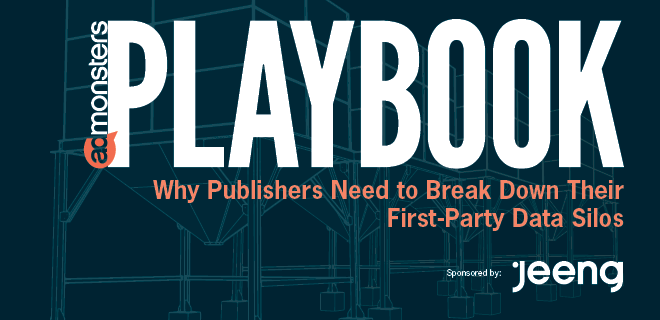First-party data is the key to surviving a cookieless world — which we all know is on the horizon. With first-party data at their fingertips, publishers can deliver personalized experiences that keep users engaged.
The problem is that only 10% of publishers say they’re doing a good job of this. And 24% say they’re not delivering harmonized customer experiences across channels. That’s what we found in the new AdMonsters Playbook: Why Publishers Need to Break Down Their First-Party Data Silos, sponsored by Jeeng.
So, why are publishers having a hard time creating individualized content for their audiences? Because they’re not effectively sharing their first-party data internally. Only by syncing data between departments and touchpoints can publishers build truly harmonized, cross-channel experiences that speak to each individual user.
To find out just how and why publishers should make this happen, we partnered with AdMonsters to survey marketing and sales team members, data scientists, chief revenue officers, and other personnel of leading digital publishing companies.
Here’s a look at what we found.
Which engagement channels are publishers using?
First, publishers identified the channels they’re using to engage audiences with content and ad campaigns. Their top channels include desktop and mobile websites, email newsletters, mobile apps, and push notifications
How are publishers collecting first-party data?
Publishers have unique opportunities to collect first-party data from their users in exchange for delivering value. For example, publishers can invite readers to sign up for email newsletters. The publisher receives a valuable piece of first-party data — the email address — and the reader receives reliable content delivered right to their inbox.
In fact, 60% of survey respondents said they gather first-party data by asking their readers to register for their site. As a result, they collect data that can be broken down by:
How do publishers plan to use first-party data?
Once they have that first-party data at their disposal, publishers plan to use it to customize organic content and ad campaigns, build better brand partnerships, and create a more harmonized experience across channels.
How do you define a harmonized cross-channel user experience?
Digging in further, we asked publishers to share what a seamless, cross-channel user experience actually looks like. 70% said it means users can enjoy consistent content that matches their interests across platforms.
And why is it so important to deliver these harmonized experiences across channels? Because it motivates people to spend more time with your content and it leads to more revenue-driving opportunities.
What are the biggest challenges to delivering those cross-channel experiences?
Evidently, it’s crucial to engage audiences with personalized, comprehensive experiences. So what’s preventing publishers from doing this effectively?
In short: Data silos.
Even though advertisers have been stressing the importance of breaking down silos between departments for years, many publishers are still struggling to foster cross-departmental collaboration. In fact, over half say they rarely or never work with other teams to build user experiences.
Meanwhile, other major challenges include finding common KPIs between teams, formatting data for easy use, and finding ways to access and share data across the organization.
Ready to learn more about managing your first-party data and building personalized experiences for your audience?
Download the AdMonsters Playbook: Why Publishers Need to Break Down Their First-Party Data Silos.

